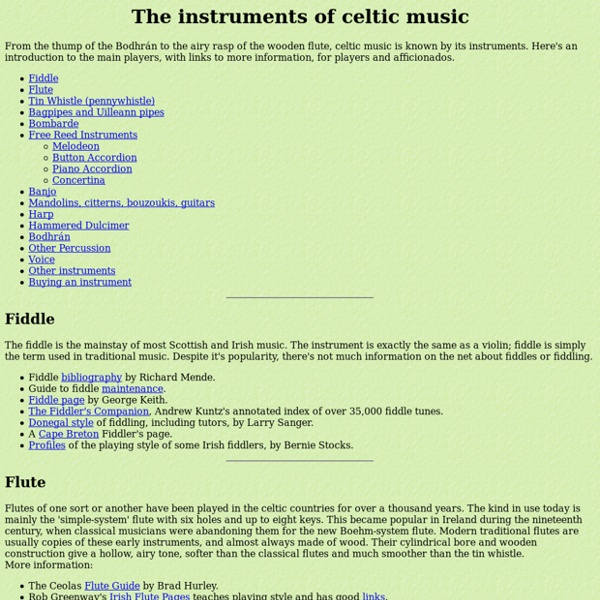Zoom
Trash
Related:



http://www.ceolas.org/instruments/
History of Celtic Music - Celtic Rings Ltd Celtic music is defined as music that originates from the countries of Ireland, Scotland and Wales. The people who live in these locations are known as Celts, which is how the music became known as Celtic music. Celtic music is best described as a type of folk music with a distinctive music and lyrics. And, today Celtic music is played and heard not only in Ireland, Scotland and Wales, but also on a worldwide stage. Celtic music has been traced back to the 1600's and is still a popular musical genre today. Celtic music can be defined also as music of the Celt people and has been around for several centuries.
Classic Celtic Music from Smithsonian Folkways - Smithsonian Folkways Various Artists Few genres carry such a rich and deep history as Celtic music, which reflects centuries of culture of Ireland and the British Isles, as well as their North American inheritors. Music historian, musician, and folklorist Richard Carlin delves into this diverse world of traditional music, compiling a wide spectrum of 23 tracks that contrast the better-known early recordings with some of the best contemporary interpreters. Styles ranging from Sligo fiddle tunes to Northumbrian piping to sean nós singing are represented in this enjoyable introduction to the Celtic music riches of the Smithsonian Folkways archives. 58 minutes, 40-page booklet with photos.
History of Celtic Music Celtic music is defined as music that originates from the countries of Ireland, Scotland and Wales. The people who live in these locations are known as Celts, which is how the music became known as Celtic music. Celtic music is best described as a type of folk music with a distinctive music and lyrics. And, today Celtic music is played and heard not only in Ireland, Scotland and Wales, but also on a worldwide stage. Celtic music has been traced back to the 1600's and is still a popular musical genre today. Celtic music can be defined also as music of the Celt people and has been around for several centuries. 5 traditional musical instruments from Ireland 5 traditional musical instruments from Ireland Ireland’s traditional music (or trad as we call it) has been around centuries — we even discovered a set of wooden pipes in County Wicklow that date back to the Stone Age to prove it. Here, we look at five trad instruments that musicians from Ireland have been blowing, strumming, picking, plucking and thumping for a very long time indeed. Bodhrán Pronounced “bow-rawn,” this is known as the heartbeat of trad music for good reason.
Japanese Traditional Music Traditional Japanese music usually refers to Japan's historical folk music. One of the defining characteristics of traditional Japanese music is its sparse rhythm. Regular chords are also absent. It is impossible for a person to beat time to the music. 30+ Outstanding Celtic Songs, Artists, and Music If you are of Irish, Scottish, Welsh, or Gaelic descent, Celtic music is probably a part of your ancient heritage. Derived from stories passed down from generation to generation, Celtic music is folklore and poetry sung for entertainment. There are many divisions of Celtic music outside of the more commercial music done by artists such as Celtic Woman. I hope you enjoy this collection of songs and artists.
Enya - Songwriter, Singer Irish singer Enya performed with her family's band Clannad before making it big with her solo album Watermark in 1988. Synopsis Enya was born on May 17, 1961, in Ireland, Enya performed with her family's band Clannad. Her first solo success came from producing ethereal music for the BBC TV show The Celts. Irish singers - The world's best singers of Irish folk music Irish singers – great performers past and present Ireland has produced a host of great singers who have made Irish traditional music popular across the world. These are some of the most prominent names.
Traditional Music of Japan — Encyclopedia of Japan Ancient Japanese MusicAlmost nothing is known about music in Japan's prehistory, through the Jomon and Yayoi periods, but there are ritual figures of musicians, suggesting the early importance of music. The late Yayoi period is marked by the building of immense tombs, and there were probably many powerful clans that gradually culminated in the dominance of the Yamato clan. The state that they built used language, religion and legal systems from the Asian continent and resulted in the high development of the imperial court as a political and cultural center in the Nara (645 - 710) and Heian (794 - 1185) periods. Even when the political power of the imperial court declined after this time, the court retained its cultural traditions, many which continue to this day.
Artist Profiles: Paddy Moloney Dublin native Paddy Moloney taught himself how to play the tin whistle when he was six and learned the basics of music at school each day. Shortly after, he picked up the Uilleann pipes, and was taught by master piper Leo Rowsome. Moloney was not influenced by other players. japan Article MT088 An overview of solo and ensemble development [Introduction] [Aesthetics] [Teaching] [Historical Background] [The Biwa] [The Koto] [The Shakuhachi] [The Shamisen] [Ensemble Music] [Conclusion] [CDs of Japanese Music] [References]